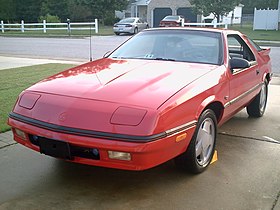This article needs additional citations for verification. (December 2018) |
| Dodge Daytona | |
|---|---|
 1991 Dodge Daytona C/S | |
| Overview | |
| Manufacturer | Dodge (Chrysler) |
| Also called | Chrysler Laser Chrysler Daytona Chrysler GS |
| Production | October 1983–February 1993 |
| Model years | 1984–1993 |
| Assembly |
|
| Body and chassis | |
| Class | Sports car |
| Body style | 3-door hatchback |
| Layout | FF layout |
| Platform | G-body |
| Powertrain | |
| Engine | |
| Transmission | 5-speed manual 3-speed automatic 4-speed automatic |
| Dimensions | |
| Wheelbase | 1987–89: 97.0 in (2,464 mm) 1990–93: 97.2 in (2,469 mm) |
| Length | 1987–1991: 179.2 in (4,552 mm) 1990–93 ES & IROC: 179.8 in (4,567 mm) 1992–93 Base: 179.0 in (4,547 mm) |
| Width | 69.3 in (1,760 mm) |
| Height | 1987–89: 50.1 in (1,273 mm) 1990–93: 50.3 in (1,278 mm) 1990–91 IROC & 1992–93 IROC R/T: 50.6 in (1,285 mm) 1992–93 IROC: 50.4 in (1,280 mm) |
| Chronology | |
| Predecessor | Dodge Challenger |
| Successor | Dodge Avenger Plymouth Laser Chrysler LeBaron coupe (for Chrysler Laser) |
The Dodge Daytona is an automobile which was produced by the Chrysler Corporation under their Dodge division from 1984 until 1993. It was a front-wheel drive hatchback based on the Chrysler G platform, which was derived from the Chrysler K platform. The Chrysler Laser was an upscale rebadged version of the Daytona. The Daytona was restyled for 1987, and again for 1992. It replaced the Mitsubishi Galant-based Challenger, and slotted between the Charger and the Conquest. The Daytona was replaced by the 1995 Dodge Avenger, which was built by Mitsubishi Motors. The Daytona derives its name mainly from the Dodge Charger Daytona, which itself was named after the Daytona 500 race in Daytona Beach, Florida.